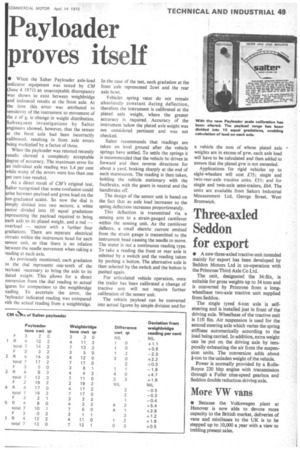Payloader proves itself
Page 51

If you've noticed an error in this article please click here to report it so we can fix it.
• When the Salter Payloader axle-load indicator equipment was tested by CM (June 4 1971) an unacceptable discrepancy was shown to exist between weighbridge and indicated results at the front axle. At the time this error was attributed to sensitivity of the instrument to movement of the c of g, ie change in weight distribution. Subsequent investigations by Salter engineers showed, however, that the sensor at the front, axle had been incorrectly calibrated, resulting in front axle errors being multiplied by a factor of three.
When the payloader was retested recently esults showed a 'completely acceptable degree of accuracy. The maximum error for an individual axle reading was 5.4 per cent hile many of the errors were less than one er cent (see results).
As a direct result of CM'S original test, Salter recognized that some confusion could rise between payload and gross load on the on-graduated scales. So now the dial is imply divided into two sectors, a white ector divided into 10 equal gradations eprescnting the payload required to bring each axle to its plated weight, and a red — overload — sector with a further four gradations. There are separate electrical circuits within the instrument head for each sensor unit, so that there is no relation between the needle movement when taking a reading at each axle.
As previously mentioned, each gradation )11 the dial represents one-tenth of the myload necessary to bring the axle to its )1ated weight. This allows for a direct ;onversion from the dial reading to actual igures for comparison to the weighbridge eading. To ascertain the error, the 3ayloader indicated reading was compared vith the actual reading from a weighbridge. In the case of the test, each gradation at the front axle represented 2cwt and the rear axle 6cwt.
Vehicles spring rates do not remain absolutely constant during deflection, therefore the instrument is calibrated at the plated axle weight, where the greater accuracy is required. Accuracy of the instrument below the plated axle weight was not considered pertinent and was not checked.
Salter recommends that readings are taken on level ground after the vehicle springs have settled. To settle the springs it is recommended that the vehicle be driven in forward and then reverse directions for about a yard, braking sharply at the end of each manoeuvre. The reading is then taken, holding the vehicle stationary with the footbrake, with the gears in neutral and the handbrake off.
The design of the sensor unit is based on the fact that as axle load increases so the spring deflection increases proportionately.
This deflection is transmitted via a sensing arm to a strain-gauged cantilever within the sensing unit. As the cantilever deflects, a small electric current emitted from the strain gauge is transmitted to the instrument head causing the needle to move. The meter is not a continuous reading type. To take a reading the front or rear axle is selected by a switch and the reading taken by pushing a button. The alternative axle is then selected by the switch and the button is pushed again.
For articulated vehicle operation, once the trailer has been calibrated a change of tractive unit will not require further calibration of the sensor unit.
The vehicle payload can be converted into actual figures by simple division and for a vehicle the sum of whose plated axle • weights are in excess of gvw, each axle load will have to be calculated and then added to ensure that the plated gvw is not exceeded.
Applications for rigid vehicles up to eight-wheelers will cost £75; single and twin-rear-axle tractive units, £51; and for single and twin-axle semi-trailers, £64. The units are available from Salters Industrial Measurement Ltd, George Street, West Bromwich.




















































































































































